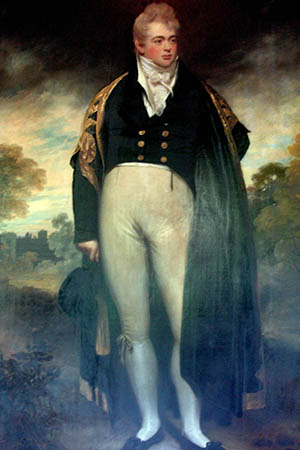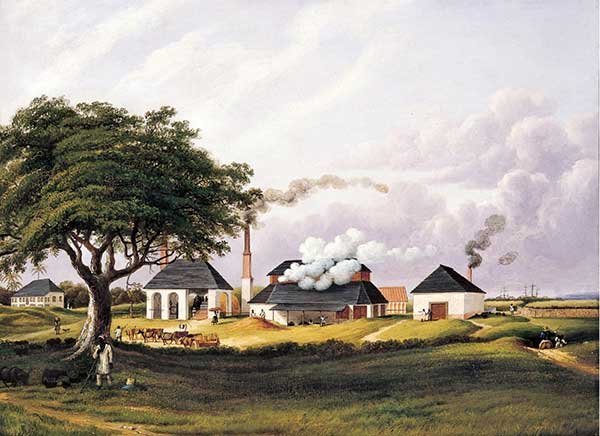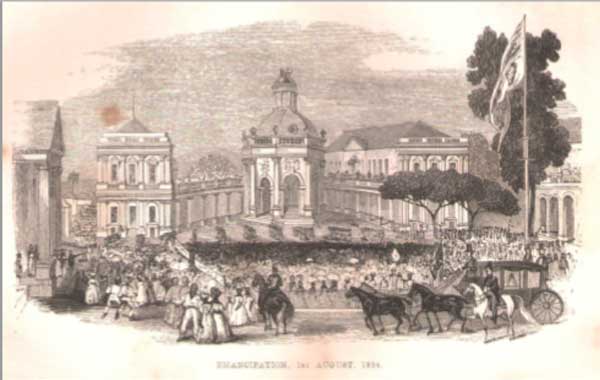‘Champion of the Slaves’—Howe Peter Browne, 2nd marquess of Sligo (1788–1845)
Published in 18th-19th Century Social Perspectives, Features, Issue 1 (January/February 2018), Volume 26As racism rears its head in the 21st century, an account of the efforts of one Irishman in the fight against slavery in the nineteenth century is timely.
By Anne Chambers

Above: Howe Peter Browne, 2nd marquess of Sligo (1788–1845).
The only child and heir of John Denis, 1st marquess of Sligo, of Westport House, Co. Mayo, and his wife Louisa Catherine, daughter and co-heiress of Admiral Howe, British naval hero, victor of the ‘Glorious First of June’ and counsellor to King George III, Howe Peter Browne was reared in a climate of wealth and privilege. On the death of his father, at the age of 21 he inherited five titles in the peerage, a 200,000-acre estate in the west of Ireland and valuable sugar plantations in Jamaica. Educated at Cambridge, his youth conformed to the popular image of a ‘buck’ in the notorious world of the prince regent at Holland House, Brighton and Newmarket, from the gambling houses, bawdy houses and theatres of London to the salons of Paris, in the company of such profligates as Lord Byron, John Cam Hobhouse and Scrope Davies. A patron of pugilists, dancers, courtesans and artists, he also became a successful horse-breeder and was a founder member and steward of the Irish Turf Club.
Treasure-hunting
In 1810, during the Napoleonic War, in the company of the radical Lady Hester Stanhope and her lover, Michael (Lavallette) Bruce, he set out on the mandatory ‘grand tour’. But Sligo’s tour was destined to be different. Chartering a ship in Malta for treasure-seeking in Greece, to navigate his way through the Mediterranean he kidnapped some seamen from a British man-of-war. He linked up with Byron and the two friends journeyed from Athens to Corinth. Sligo excavated at Mycenae and located the famous columns to the Treasury of Atreus (now in the British Museum) before moving on to Turkey. Despite his grandfather’s status as a maritime hero, on his return home he was indicted by the British Admiralty and in December 1812 was publicly tried at the Old Bailey, where he was found guilty, fined and imprisoned in Newgate.
Sobered by his sojourn in goal and by his marriage in 1816 to Catherine de Burgh, daughter of the earl of Clanricarde, by whom he had fourteen children, Sligo eventually settled down to the responsibilities of his estate in the west of Ireland. In an age in Ireland not endowed with improving landlords he was an exception. A passionate advocate of Catholic Emancipation, multi-denominational education and legal reform, he tried his best to alleviate the desperate circumstances of his tenants, aggravated by a rapidly rising population and the ‘curse’ of subdivision, which resulted in more and more people dependent on less and less land for their survival. With few other outlets for employment, he established a cotton factory in Westport in order, as he wrote, ‘to benefit this Country by introducing such manufactures into it as will give employment to the People … unless I do it to show the way nobody will follow’. He encouraged the development of kelp-harvesting and fishing and revitalised mining development in the area. He promoted trade and manufacturing in the town and port of Westport and influenced the establishment of the first bank there in 1825. As famine-like conditions engulfed the west of Ireland in 1831, at his own expense he imported cargos of grain and potatoes, built a hospital and dispensary to care for the sick and, through his contacts in the government, helped raise money for famine relief and to establish additional public works.
Governor of Jamaica
On his appointment as governor-general of Jamaica and the Cayman Islands in 1834, his liberal and improving endeavours were transferred across the Atlantic to take on the brutal system of slavery. While the importation of slaves from Africa had been abolished in 1807, slavery—the cornerstone of sugar production and profit in the British West Indies—continued. Missionaries conveyed the horrors of the slavery system to the British public, and in 1833 the government finally passed an Emancipation Act.
The Act, however, did not give immediate freedom to the slaves, who merely became ‘apprenticed’ to their masters for a further four years. Described as ‘slavery under another name’ by abolitionists, the controversial ‘apprenticeship system’ that Sligo was appointed to implement was misunderstood by the slaves and resisted both by the Jamaican plantocracy and by powerful commercial vested interests in Britain.
As the owner of two plantations on the island, which he inherited from his grandmother Elizabeth Kelly, heiress of Denis Kelly, former chief justice of Jamaica, the planters expected Sligo to be on their side. His objective, however, as he informed them on his arrival—to establish a social system ‘absolved forever from the reproach of slavery’—set them on a collision course.
Sligo found the savagery of slavery personally abhorrent. From the flogging of field workers with cart whips and branding with hot irons to the whipping of female slaves, the mantra ‘a strip on the shoulder makes a furrow in the land’ governed every aspect of the slave’s life. ‘The cruelties are past all idea’, Sligo told the Jamaican Assembly. ‘I call on you to put an end to conduct so repugnant to humanity.’
‘Gave a patient hearing to the poorest Negro’
To counteract the worst excesses, he maintained personal contact and control over the 60 special magistrates appointed to oversee the implementation of the new apprenticeship system in the c. 900 plantations throughout the island. Much to the derision and indignation of their masters, and unprecedented in the colonies, he ‘gave a patient hearing to the poorest Negro which might carry his grievance to Government House’. Against the determined opposition of the Jamaican parliament, he advocated the building of schools for the black population, that they might extract maximum benefit from their future freedom, two of which he built at his own cost on his property. He was the first plantation-owner to initiate a wage system for black workers on his estates, and later, after emancipation, to divide his lands into numerous farms to be leased to the former slaves.
As he had done in Ireland, Sligo set out to reform the Jamaican legal system and the notoriously corrupt court of chancery, where he discovered abuses ‘almost too frightful to enter into’. His efforts to improve communications and roads, as well as land reclamation and better husbandry practices, led to the establishment of agricultural societies on the island, of which he was patron.
His efforts on behalf of the black population were bitterly opposed by the planter-dominated Assembly, who accused him of ‘interpreting the laws in favour of the negro’ and who, as Sligo noted, ‘set out to make Jamaica too hot to hold me’. They withdrew his salary and commenced a campaign of vilification against him in the Jamaican and British press, which resulted in his eventual removal from office in September 1836.

Above: The sugar works at Kelly’s estate, 1836—one of two plantations in Jamaica inherited by Sligo from his grandmother, Elizabeth Kelly. (National Gallery of Jamaica)
Jamaica under the apprenticeship system
To the Negro population in Jamaica, however, Sligo was their champion and protector. In an unprecedented gesture, they presented him with a magnificent silver candelabrum inscribed:
‘In grateful remembrance they entertain of his unremitting efforts to relieve their suffering and to redress their wrongs during his just and enlightened administration of the Government of Jamaica.’
On his return, Sligo became a determined and outspoken campaigner for full emancipation:
‘It is treason in Jamaica to talk of a Negro as a freeman. The black and coloured population are viewed by the white inhabitants as little more than semi-human, for the most part a kind of intermediate race, possessing indeed the form of man, but none of his finer attributes.’

Above: ‘Emancipation Day’ in Spanish Town, Jamaica, 1 August 1834. The Emancipation Act, however, did not give immediate freedom to slaves, who became ‘apprenticed’ to their masters for a further four years. (J.M. Phillipo, Jamaica: its past and present state)
One of his anti-slavery pamphlets, Jamaica under the apprenticeship system, was debated in the British parliament and influenced the ‘great debate’ on emancipation in February 1838. On 22 March 1838, being, as he noted, ‘well aware that it would put an end to the [slavery] system’, he announced in the House of Lords that, regardless of the British government’s deliberations, he proposed to free all apprentices on his own estates in Jamaica on 1 August 1838.
‘I am confident that no person who is acquainted with the state of the West Indian colonies and at the same time uninfected with colonial prejudices will deny that the time is now come when it is important to effect a final arrangement of this question.’
His public pronouncement left the British government with no alternative but to implement full emancipation on the same date.
Lord Sligo earned an honoured place in the history of Jamaica, where he is acknowledged as ‘Champion of the Slaves’ and where the town of Sligoville, the first free slave village in the world, bears his name. Together with Wilberforce and Buxton, leaders of the anti-slavery movement, in 1838 his name was commemorated on an emancipation memorial medal. His efforts to end the slavery system in the West Indies later influenced the struggle against slavery in North America.
Anne Chambers is the author of The Great Leviathan: the life of Howe Peter Browne, 2nd marquess of Sligo, 1788–1845 (New Island, 2017).
FURTHER READING
W.L. Burn, Emancipation and apprenticeship in the British West Indies (London, 1939).
E. Longford, Wellington (London, 1992).
F. MacCarthy, Byron: life and legend (London, 2002).
















